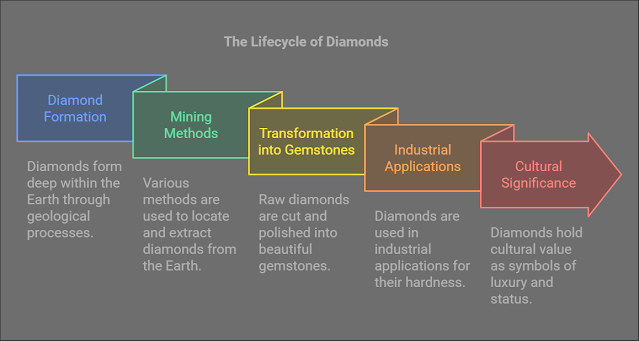- Get link
- X
- Other Apps
Diamond Formation, Mining, and Uses
This document explores the fascinating journey of diamonds from their formation deep within the Earth to their various applications in modern society. It delves into the geological processes that create diamonds, the methods used for mining them, their transformation into beautiful gemstones, and the significance they hold in both industrial and cultural contexts. By understanding the lifecycle of diamonds, we can appreciate their rarity, value, and the allure they have held throughout history.
I. Diamond Formation Deep Within the Earth
A. The Geological Origins of Diamonds
Diamonds are formed from carbon deep in the Earth's mantle under immense heat and pressure over billions of years. The extreme conditions required for their formation create a unique crystalline structure, making diamonds one of the hardest natural substances on Earth.
B. Kimberlite Pipes as Natural Elevators
Volcanic eruptions bring diamonds to the Earth's surface via kimberlite pipes, which act as underground tunnels or elevators. These pipes are formed during explosive volcanic activity, allowing diamonds to be deposited in areas where ancient volcanoes once existed.
II. Methods of Diamond Mining
A. Locating Diamond Deposits
Geologists play a crucial role in identifying areas with potential diamond deposits by recognizing signs of old volcanoes and kimberlite pipes. Their expertise helps in pinpointing locations where diamonds are likely to be found.
B. Open-Pit Mining Techniques
Open-pit mining involves extracting diamonds through massive pits where layers of rock are removed by machinery. This method is often used when diamond deposits are located near the surface.
C. Underground Mining Methods
For diamonds found deeper underground, workers dig tunnels using specialized equipment to access the deposits. This method requires careful planning and safety measures to ensure the well-being of the miners.
D. Processing Raw Materials
Once extracted, rocks containing diamonds are sent to factories for crushing and washing. This process separates the diamonds from the surrounding material, allowing for further refinement.
E. Alluvial Mining in Rivers
Some diamonds are transported through rivers and can be found using a gold-panning style process. This method results in smoother and shinier stones, as they have been naturally polished by the water.
III. Diamond Transformation & Properties
A. Gem Cutting and Polishing
Expert gem cutters use specialized tools and techniques to cut and polish diamonds, enhancing their sparkle and shaping them into desired forms. This transformation is crucial for maximizing a diamond's aesthetic appeal.
B. Diamond Variety
Diamonds come in a wide range of colors, sizes, and qualities, with no two being identical. Rare colors and larger sizes significantly increase a diamond's value, making them highly sought after.
C. The Four C’s
The quality of a diamond is determined by four key characteristics: cut, clarity, color, and carat weight. Each of these factors plays a vital role in assessing a diamond's overall value and desirability.
IV. Global Diamond Sources
A. South Africa
South Africa has a rich history as a significant diamond source, known for famous finds like the Cullinan Diamond, which is one of the largest diamonds ever discovered.
B. Russia
Russia is a major player in diamond mining, boasting rich deposits despite the challenges posed by harsh, cold weather conditions. The country is known for producing a substantial portion of the world's diamonds.
C. Botswana
Botswana is recognized as a key producer of high-quality diamonds that are in high demand globally. The country's diamond industry has played a crucial role in its economic development.
D. Canada
Canada has emerged as a surprising source of diamonds, with mines that operate year-round despite the cold climate. Canadian diamonds are known for their ethical sourcing and high quality.
V. Uses of Diamonds
A. Industrial Applications
Diamonds' exceptional hardness makes them valuable in various industrial applications, including cutting tools for tough materials and surgical instruments for delicate procedures.
B. Symbolism in Jewelry
Diamonds have long been associated with love, power, and wealth, making them a popular choice for jewelry, especially in wedding rings and other special occasions.
VI. Diamond Rarity and Value
A. Rarity Misconception
Contrary to popular belief, diamonds are not as rare as they seem. The high cost is largely attributed to marketing tactics and the premium placed on perfect, flawless stones.
B. Control of Supply
Diamond companies carefully regulate the supply of diamonds to maintain their value in the market. This control ensures that diamonds remain a symbol of luxury and exclusivity.
C. The Importance of Quality
The true rarity of diamonds lies in finding those with exceptional qualities, such as clarity and color. These high-quality stones command significantly higher prices in the market.
VII. The Significance of Diamonds
A. Historical Journey
Each diamond has an incredible history, from its formation deep within the Earth to its final polished form. This journey adds to the allure and value of each stone.
B. The Magic of Diamonds
Diamonds are often viewed as magical and special due to their age, origin, and transformation from rough stone to sparkling gem. Their unique properties and cultural significance continue to captivate people around the world.
Angel Number 8888
Angel Number 9999
Dog
Dog food
caesars filet mignon dog food
nutro max dog food
nutromax dog food
nutra max dog food
nutramax dog food
pedigree high protein dry dog food
- Get link
- X
- Other Apps


.png)
.png)
.png)
Comments